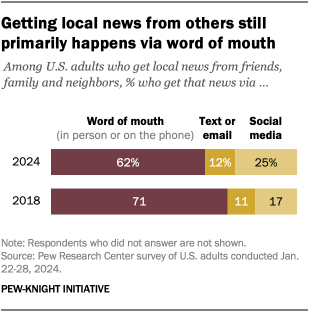For local news, Americans turn to friends, family and neighbors


The Pew-Knight Initiative supports new research on how Americans absorb civic information, form beliefs and identities, and engage in their communities.
Pew Research Center is a nonpartisan, nonadvocacy fact tank that informs the public about the issues, attitudes and trends shaping the world. Knight Foundation is a social investor committed to supporting informed and engaged communities. Learn more >

Americans’ relationship with local news is changing. More are getting news online, and fewer are turning to sources like daily newspapers, according to a Pew Research Center survey conducted earlier this year. The survey is part of the Pew-Knight Initiative, a research program funded jointly by The Pew Charitable Trusts and the John S. and James L. Knight Foundation.
However, one thing that has remained consistent is the importance of friends, family and neighbors as sources of local news for most Americans. In fact, they are the most common source of local news we asked about, ranking above television stations, radio stations and online forums like Facebook groups.
About three-quarters of Americans (73%) say they often or sometimes get local news from friends, family and neighbors. The next-highest source is TV stations, at 64%. In 2018, friends and family were also a common source of local news but had not yet surpassed TV.
Friends, family and neighbors are a key source of local news for majorities of Americans regardless of age, political party, race or ethnicity.
This Pew Research Center analysis explores how U.S. adults get local news and information from friends, family and neighbors.
The survey of 5,146 U.S. adults was conducted from Jan. 22 to 28, 2024. Everyone who completed the survey is a member of the Center’s American Trends Panel (ATP), an online survey panel that is recruited through national, random sampling of residential addresses. This way nearly all U.S. adults have a chance of selection. The survey is weighted to be representative of the U.S. adult population by gender, race, ethnicity, partisan affiliation, education and other categories. Read more about the ATP’s methodology.
Here are the questions used for this analysis, the topline and the survey methodology.
This is a Pew Research Center report from the Pew-Knight Initiative, a research program funded jointly by The Pew Charitable Trusts and the John S. and James L. Knight Foundation. Find related reports online at
How people get local news from those they know

Even as news consumption is becoming more digital, local news exchanges among friends, family and neighbors still largely happen through word of mouth (in person or over the phone) as opposed to on social media, in emails or in texts. A majority (62%) of those who get local news from friends and family say they usually get this news via word of mouth.
This share is down from the 71% of Americans who said they got this news via word of mouth in 2018. Meanwhile, the share who get it via social media has increased from 17% in 2018 to 25% in 2024.
Getting local news on specific topics
Friends, family and neighbors are also among the top sources for two of the most common local news topics: politics and crime. About seven-in-ten Americans say they get local government news and local crime news from friends, family and neighbors. That’s about the same share as those who say they get local political and crime news from news outlets.

Social interaction is also a way Americans commonly respond to local crime news.
About three-quarters of U.S. adults (73%) say they have spoken with friends, family or neighbors about crime in their local community. That’s far higher than the shares who say they’ve posted or shared on social media or elsewhere online (21%), spoken to local officials or police (19%), or communicated with a journalist (5%).

Most people (72%) who get news about local crime from friends, family and neighbors think it is at least somewhat accurate, although just 10% say it is very accurate. An additional 17% say it is not too or not at all accurate, while 10% aren’t sure. The share who say it is at least somewhat accurate is higher than the share who say the same about news from locally focused apps like Nextdoor, social media or local politicians.
About one-in-five Americans (22%) say the information they get about local crime from friends, family and neighbors exaggerates the amount of crime in their community. Another 7% say their friends and family underplay the amount of crime. Still, 52% say their friends and family get it about right.
Note: Here are the questions used for this analysis, the topline and the survey methodology.
link







